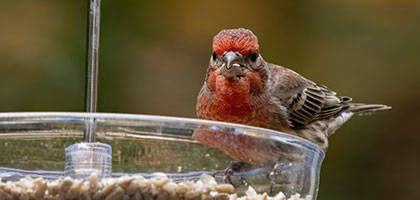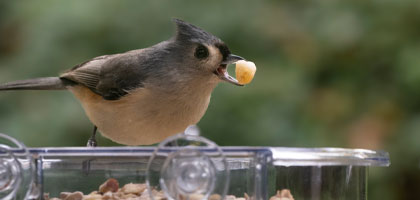Backyard bird feeders can bring a flurry of feathered friends to your garden. They offer a unique opportunity to observe bird behavior up close.
But how do you use a backyard bird feeder effectively?
This guide will walk you through the process. From choosing the right feeder to maintaining it, we've got you covered.
You'll learn about different bird feeder types and bird feeder ideas. We'll also discuss how to attract a variety of backyard birds.
By the end, you'll be well-equipped to enhance your bird-watching experience. Let's get started.
Choosing the Right Bird Feeder
Selecting the right bird feeder can impact which birds visit your yard. Different types of feeders cater to different species and feeding habits.
There are several types of bird feeders to consider:
- Tube feeders: Good for small birds like finches and chickadees.
- Platform feeders: Attract a variety of birds but can get messy.
- Window feeders: Perfect for up-close views; attach directly to your window.
- Hopper feeders: Hold more seed and protect it from weather.
Each feeder type has its pros and cons. Choose one that aligns with your backyard bird goals and your garden space. The right feeder can attract the birds you wish to observe.
Selecting the Perfect Location
Positioning your bird feeder correctly is vital for attracting birds. Choose a spot that offers safety and accessibility.
Place the feeder in a quiet area where birds won't feel threatened. Avoid busy paths or areas with frequent foot traffic.
Ensure the feeder is visible to birds yet safe from predators. A distance of about 10-12 feet from trees or bushes is ideal to provide natural refuge.
Consider the proximity to windows to prevent collisions. Using decals or screens can mitigate this risk. Proper placement will encourage more bird visits to your feeder.
Filling Your Bird Feeder with the Right Seed
Selecting the right seed is crucial for attracting specific bird species. Different birds prefer different seed types, which influences which guests visit your feeder.
Start by considering black oil sunflower seeds. They're a favorite for many backyard birds due to their high-fat content and easy shell.
Millet is another excellent choice, attracting ground-feeding birds like sparrows. Make sure to offer a range of seeds for a diverse bird population.
Common Seed Types and Their Bird Visitors
- Black Oil Sunflower Seeds: Cardinals, jays, finches
- Millet: Sparrows, doves
- Nyjer: Goldfinches, siskins
- Cracked Corn: Jays, doves
Variety is key when filling your feeder. By providing multiple seed types, you'll encourage a wider range of birds to visit. This enhances your bird-watching experience and promotes biodiversity.
Regular Maintenance for a Healthy Bird Habitat
Maintaining your bird feeder is essential to keep your backyard birds healthy and happy. Regular cleaning prevents disease spread among the feathered visitors.
Develop a cleaning routine for your feeders. Weekly cleanings with a mild bleach solution can help. Rinse thoroughly and allow to dry completely before refilling.
A consistent refilling schedule is equally important. This ensures that birds can rely on your backyard bird feeder for nutrition.
Cleaning and Refilling Schedule
- Clean weekly: Use a bleach solution
- Inspect for damage: Prevents harmful conditions
- Refill regularly: Keep feeders stocked
Keeping up with maintenance not only benefits the birds but also ensures that your backyard remains a safe and inviting place for them to feed. Proper care enhances your enjoyment of this rewarding hobby.
Deterring Unwanted Guests
Squirrels and other critters often see backyard bird feeders as an easy food source. It's important to implement strategies to keep them at bay.
Consider using squirrel-proof feeders. These are designed with mechanisms that thwart these agile intruders, keeping your seed safe.
Placement also plays a role in deterring pests. Hang feeders away from trees and fences, reducing easy access points for squirrels.
Additionally, you can invest in baffles. These are dome-shaped barriers placed above or below feeders to prevent climbing or jumping pests. They add an extra layer of defense while ensuring that your backyard birds can feed in peace.
Providing Water and Natural Food Sources
Water is essential for birds, not just for drinking but also for bathing. Installing a birdbath is an excellent way to provide this necessity.
Choose a shallow birdbath with a gentle slope. This ensures the safety of the birds and attracts more species to your yard.
In addition to water, consider enhancing your backyard with native plants. These plants can offer natural food options like berries and insects.
Creating a diverse habitat with native flora supports the nutritional needs of various bird species. It complements your bird feeder, encouraging a more vibrant bird population in your backyard.
Seasonal Considerations for Your Feathered Friends
Bird feeding is not a one-size-fits-all activity. Each season presents unique challenges and opportunities for bird enthusiasts.
In winter, food scarcity makes bird feeders vital. Providing high-energy seeds like sunflower can help birds survive the cold months.
Spring brings migration and breeding season. This is when protein-rich foods like mealworms are especially beneficial to birds.
During summer, fruits and nectar can draw different bird species. They complement natural food sources, catering to birds' varied dietary needs. Taking these seasonal nuances into account boosts your backyard's appeal to birds year-round.
Safety and Conservation: Protecting Our Backyard Birds
Creating a safe haven for backyard birds is crucial. Ensuring their safety encourages their regular visits and well-being.
Window collisions pose a significant risk to birds. Position feeders at least three feet from windows or use decals to reduce reflections.
Predators like cats can also threaten birds at feeders. Keeping feeders high off the ground and away from cover helps minimize this risk.
Moreover, bird feeders should aid conservation efforts. Avoid using feeders in a way that makes birds overly dependent on them. Instead, see them as a supplement to natural food sources. This balance promotes healthy bird behaviors and supports local ecosystems.
Conclusion: The Rewards of Bird Feeding
Feeding backyard birds provides countless rewards. It brings joy and tranquility right to your home, making it a haven for nature's visitors. Watching birds flit about your yard can be a therapeutic experience, lifting your spirits.
Beyond personal enjoyment, bird feeding supports local wildlife. It offers essential food sources, especially during harsh seasons. By providing sustenance, you help maintain a balanced ecosystem in your area.
Bird feeding also fosters learning and appreciation for nature. Observing different species helps improve your understanding of avian behaviors and needs. You gain a deeper connection to the natural world around you.
Finally, sharing bird feeding with family or friends strengthens bonds. It becomes a shared hobby full of education and excitement. Whether alone or with others, bird feeding enriches your life and contributes positively to your environment.






